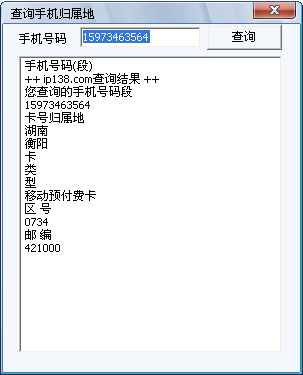Python手机号码归属地查询代码
简单的一个例子,是以前用Dephi写的,前不久刚实现了一个在Python中使用Delphi控件来编写界面程序,于是趁热写一个类似的的查询方案。
本实例是通过www.ip138.com这个网站来查询的,这里需要的几个知识点,就是用Python模拟网页提交数据,获得数据返回信息,以及对返回的Html信息进行解析,模拟Http提交,Python自带有一个urllib和urllib2这两个库,相当方便,只是奇怪,为什么不将两个库合并成一个,这样来的更方便。然后就是窗体了,窗体还是用我之前写的一个Python模块DxVcl,就是可以在Python中调用Delphi界面控件的一个模块库。下面就贴上代码,相当简单的!
#-*-coding: gb2312 -*-
import urllib,urllib2,HTMLParser
from DxVcl import*
class MyParser(HTMLParser.HTMLParser):
def reset(self):
self._isInTd = False
self._retdata = []
HTMLParser.HTMLParser.reset(self)
def handle_starttag(self,tag,attris):
self._isInTd = tag =='td'
def handle_endtag(self,tag):
if self._isInTd:
self._isInTd = False
def handle_data(self,data):
if self._isInTd:
self._retdata.append(data)
class MainForm(Form):
def__init__(self,Owner):
self.Caption ='查询手机归属地'
self.Position =5
self.BorderStyle =3
self.Width =303
self.Height =375
self.lbl = Label(self)
self.lbl.SetProps(Parent = self,Caption ='手机号码')
self.lbl.SetBounds(16,8,60,13)
self.EdtPhone = Edit(self)
self.EdtPhone.SetProps(Parent = self,Text ='')
self.EdtPhone.SetBounds(77,3,121,21)
self.Button1 = Button(self)
self.Button1.SetProps(Parent = self,Caption ='查询')
self.Button1.SetBounds(204,1,75,25)
self.Button1.OnClick = self.Button1Click
self.Memo1 = Memo(self)
self.Memo1.Parent = self
self.Memo1.SetBounds(16,32,263,297)
def Button1Click(self,Sender):
postdata = urllib.urlencode([('action','mobile'),('mobile',self.EdtPhone.Text)])
req = urllib2.Request('http://www.ip138.com:8080/search.asp')
fd = urllib2.urlopen(req,postdata)
h = fd.read()
my = MyParser()
my.feed(h)
self.Memo1.Lines.Clear()
for data in my._retdata:
self.Memo1.Lines.Add(data)
def main():
FreeConsole()
Application.Initialize()
Application.Title ='查询手机归属'
f = MainForm(Application)
f.Show()
Application.Run()
if__name__=='__main__':
main()运行之后的界面

以上所述是小编给大家介绍的Python手机号码归属地查询代码,希望对大家有所帮助!

Hot AI Tools

Undresser.AI Undress
AI-powered app for creating realistic nude photos

AI Clothes Remover
Online AI tool for removing clothes from photos.

Undress AI Tool
Undress images for free

Clothoff.io
AI clothes remover

AI Hentai Generator
Generate AI Hentai for free.

Hot Article

Hot Tools

Notepad++7.3.1
Easy-to-use and free code editor

SublimeText3 Chinese version
Chinese version, very easy to use

Zend Studio 13.0.1
Powerful PHP integrated development environment

Dreamweaver CS6
Visual web development tools

SublimeText3 Mac version
God-level code editing software (SublimeText3)

Hot Topics
 How to Use Python to Find the Zipf Distribution of a Text File
Mar 05, 2025 am 09:58 AM
How to Use Python to Find the Zipf Distribution of a Text File
Mar 05, 2025 am 09:58 AM
This tutorial demonstrates how to use Python to process the statistical concept of Zipf's law and demonstrates the efficiency of Python's reading and sorting large text files when processing the law. You may be wondering what the term Zipf distribution means. To understand this term, we first need to define Zipf's law. Don't worry, I'll try to simplify the instructions. Zipf's Law Zipf's law simply means: in a large natural language corpus, the most frequently occurring words appear about twice as frequently as the second frequent words, three times as the third frequent words, four times as the fourth frequent words, and so on. Let's look at an example. If you look at the Brown corpus in American English, you will notice that the most frequent word is "th
 How Do I Use Beautiful Soup to Parse HTML?
Mar 10, 2025 pm 06:54 PM
How Do I Use Beautiful Soup to Parse HTML?
Mar 10, 2025 pm 06:54 PM
This article explains how to use Beautiful Soup, a Python library, to parse HTML. It details common methods like find(), find_all(), select(), and get_text() for data extraction, handling of diverse HTML structures and errors, and alternatives (Sel
 How to Perform Deep Learning with TensorFlow or PyTorch?
Mar 10, 2025 pm 06:52 PM
How to Perform Deep Learning with TensorFlow or PyTorch?
Mar 10, 2025 pm 06:52 PM
This article compares TensorFlow and PyTorch for deep learning. It details the steps involved: data preparation, model building, training, evaluation, and deployment. Key differences between the frameworks, particularly regarding computational grap
 Serialization and Deserialization of Python Objects: Part 1
Mar 08, 2025 am 09:39 AM
Serialization and Deserialization of Python Objects: Part 1
Mar 08, 2025 am 09:39 AM
Serialization and deserialization of Python objects are key aspects of any non-trivial program. If you save something to a Python file, you do object serialization and deserialization if you read the configuration file, or if you respond to an HTTP request. In a sense, serialization and deserialization are the most boring things in the world. Who cares about all these formats and protocols? You want to persist or stream some Python objects and retrieve them in full at a later time. This is a great way to see the world on a conceptual level. However, on a practical level, the serialization scheme, format or protocol you choose may determine the speed, security, freedom of maintenance status, and other aspects of the program
 Mathematical Modules in Python: Statistics
Mar 09, 2025 am 11:40 AM
Mathematical Modules in Python: Statistics
Mar 09, 2025 am 11:40 AM
Python's statistics module provides powerful data statistical analysis capabilities to help us quickly understand the overall characteristics of data, such as biostatistics and business analysis. Instead of looking at data points one by one, just look at statistics such as mean or variance to discover trends and features in the original data that may be ignored, and compare large datasets more easily and effectively. This tutorial will explain how to calculate the mean and measure the degree of dispersion of the dataset. Unless otherwise stated, all functions in this module support the calculation of the mean() function instead of simply summing the average. Floating point numbers can also be used. import random import statistics from fracti
 Professional Error Handling With Python
Mar 04, 2025 am 10:58 AM
Professional Error Handling With Python
Mar 04, 2025 am 10:58 AM
In this tutorial you'll learn how to handle error conditions in Python from a whole system point of view. Error handling is a critical aspect of design, and it crosses from the lowest levels (sometimes the hardware) all the way to the end users. If y
 What are some popular Python libraries and their uses?
Mar 21, 2025 pm 06:46 PM
What are some popular Python libraries and their uses?
Mar 21, 2025 pm 06:46 PM
The article discusses popular Python libraries like NumPy, Pandas, Matplotlib, Scikit-learn, TensorFlow, Django, Flask, and Requests, detailing their uses in scientific computing, data analysis, visualization, machine learning, web development, and H
 Scraping Webpages in Python With Beautiful Soup: Search and DOM Modification
Mar 08, 2025 am 10:36 AM
Scraping Webpages in Python With Beautiful Soup: Search and DOM Modification
Mar 08, 2025 am 10:36 AM
This tutorial builds upon the previous introduction to Beautiful Soup, focusing on DOM manipulation beyond simple tree navigation. We'll explore efficient search methods and techniques for modifying HTML structure. One common DOM search method is ex






